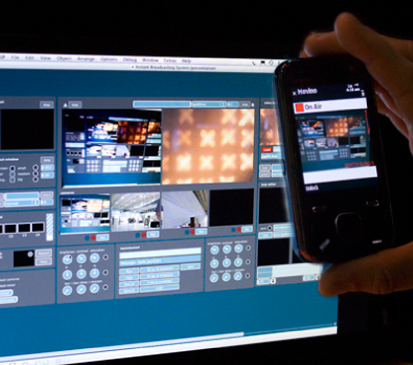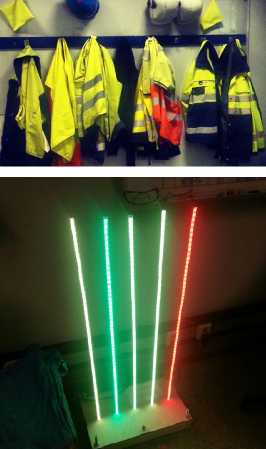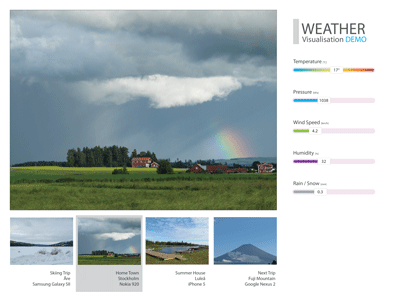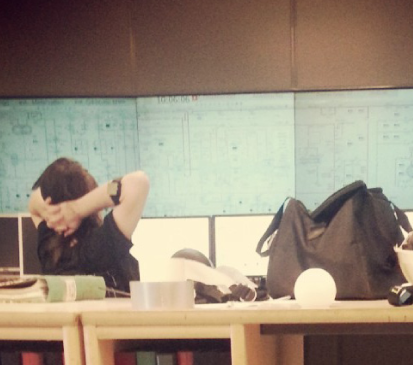January 2014 Newsletter
What's up?
What's up?

The Future of Money: People once stuffed cash under their mattresses. Now
they can carry it around on their phones. Barry Brown and his team at Mobile Life
are examining how mobile devices will affect the way we spend money in the future.
(Read more)
(Read more)
“You can discover more about a person in an hour of play than in a year of conversation.”
- Plato
- Plato
Q&A with BARRY BROWN: Welcome to Mobile Life:
Barry Brown, research director at Mobile Life, was just appointed professor at Stockholm University. This interview has been edited and condensed from a conversation held during the course of an hour in November on multiple devices: Skype on a mobile phone (battery died), Skype on a laptop (bad connection), and finally, a landline. (Read more)+
Barry Brown, research director at Mobile Life, was just appointed professor at Stockholm University. This interview has been edited and condensed from a conversation held during the course of an hour in November on multiple devices: Skype on a mobile phone (battery died), Skype on a laptop (bad connection), and finally, a landline. (Read more)
“Work consists of
whatever a body is
obliged to do. Play
consists of whatever
a body is not obliged
to do.”
- Mark Twain
- Mark Twain
The Future of Money
“People have different views of money,” says Barry Brown, a research director at Mobile Life who is leading the project the Future of Money. And they spend their money with different expectations depending on the transaction. They also have different “rituals” of buying things.
Brown compares the feeling of buying a meal at a café versus food from a supermarket: At a café, most people expect some kind of social interaction with a server – whether in ordering or in paying for their food. “It doesn’t tend to be the good restaurants where you order on a machine,” he says. Customers time paying for the bill correctly, getting their credit cards ready for a server, and bantering. “You want that human experience.” However, some people are perfectly comfortable scanning their own groceries at the store.
Yet those people might not be happy if their phone or a card in their wallet were automatically debited at the grocery. And at a café or restaurant, would you be pleased or alarmed if the server knew your habits from the credit card purchases you made in the café a month ago? Or even from other stores?
Brown and his colleagues have broken down how people use money into four categories that they can examine from a portable digital use perspective. The first and perhaps most everyday category is the point of sale, whether at a café, at the grocery, online, or elsewhere. Technically, a customer does not have to pay for anything directly anymore, using cash, or even swiping a card (your phone is capable of being automatically debited), but “there’s something about the transaction that is important to people,” Brown says.
Another major category is personal finance: how people save, and how they think about money. “The most valuable currency we have is time and none of us has enough time,” Brown says, “and few of us have a lot of money.” That shows up in our spending habits. Sometimes, people do not seem to be overly analytical or logical about their spending and saving habits, but they have their own organisational systems – for example, mentally, they will hold off on making big purchases at the end of the month, before getting paid. Will that change with more immediate electronic transactions and banking?
That leads partly into the third section of the project: Payment provision. This is how money moves through banks, credit card companies such as Visa and MasterCard, or even mobile phone companies that allow users to make payments or move money. “Payment provision runs the world,” says Brown.
Brown compares the feeling of buying a meal at a café versus food from a supermarket: At a café, most people expect some kind of social interaction with a server – whether in ordering or in paying for their food. “It doesn’t tend to be the good restaurants where you order on a machine,” he says. Customers time paying for the bill correctly, getting their credit cards ready for a server, and bantering. “You want that human experience.” However, some people are perfectly comfortable scanning their own groceries at the store.
Yet those people might not be happy if their phone or a card in their wallet were automatically debited at the grocery. And at a café or restaurant, would you be pleased or alarmed if the server knew your habits from the credit card purchases you made in the café a month ago? Or even from other stores?
Brown and his colleagues have broken down how people use money into four categories that they can examine from a portable digital use perspective. The first and perhaps most everyday category is the point of sale, whether at a café, at the grocery, online, or elsewhere. Technically, a customer does not have to pay for anything directly anymore, using cash, or even swiping a card (your phone is capable of being automatically debited), but “there’s something about the transaction that is important to people,” Brown says.
Another major category is personal finance: how people save, and how they think about money. “The most valuable currency we have is time and none of us has enough time,” Brown says, “and few of us have a lot of money.” That shows up in our spending habits. Sometimes, people do not seem to be overly analytical or logical about their spending and saving habits, but they have their own organisational systems – for example, mentally, they will hold off on making big purchases at the end of the month, before getting paid. Will that change with more immediate electronic transactions and banking?
That leads partly into the third section of the project: Payment provision. This is how money moves through banks, credit card companies such as Visa and MasterCard, or even mobile phone companies that allow users to make payments or move money. “Payment provision runs the world,” says Brown.

When large companies move money and make money off those movements, these behaviours can collide directly with such “disruptive technologies” as Bitcoin, the electronic-only currency that recently skyrocketed in value, and online markets that are legal, such as eBay or Blocket.se, or illegal, such as Silk Road.
Alternative currencies are the fourth topic for the Future of Money project: “We were going to do a program on discussions between drug dealers” on Silk Road to study the health risks of online drug sales, Brown comments, but then the black market site got closed down by the US government. Now, a collaborator at the US Centers for Disease Control will poll kids who tried to sell unused prescription drugs online to see the outcomes.
Humans, electronic devices and money come together to create a trifecta of fascinating interactions to study. “We want to try to think of how things will be 10, 20 years away and try to build with that. Rather than take the human out, can we put the human in? How could it be different?” Brown asks. “The most valuable currency we have is time and none of us has enough time, and few of us have a lot of money.” That shows up in our spending habits, and could eventually be flavoured by our electronic experiences – and vice versa.


Patent for collaborative live video production
Imagine going with a group of friends to a live event and creating your own live video feed on the spot. The Mobile Vision Mixer, developed by Oskar Juhlin and colleagues at Stockholm University, Mobile Life and Ericsson, received initial approval from the European Patent Office earlier this year.
Much like a television production crew has multiple cameras covering an event, with a producer at a central spot selecting the feeds, the application allows one central person with a 3G mobile phone to control the broadcast of video taken by four other phones. The central producer can select which phone’s perspective to broadcast in real time, switching feeds with a fingertip.
The application’s mobility and phone-centric technology made it patent-worthy, Juhlin says. While the idea is not new and has been long in production, the patent means that soon, you might be able to take that app – and four friends – with you to a hockey game, skate park, concert, or even a wedding, to produce your own live broadcasts by phone.
Much like a television production crew has multiple cameras covering an event, with a producer at a central spot selecting the feeds, the application allows one central person with a 3G mobile phone to control the broadcast of video taken by four other phones. The central producer can select which phone’s perspective to broadcast in real time, switching feeds with a fingertip.
The application’s mobility and phone-centric technology made it patent-worthy, Juhlin says. While the idea is not new and has been long in production, the patent means that soon, you might be able to take that app – and four friends – with you to a hockey game, skate park, concert, or even a wedding, to produce your own live broadcasts by phone.

Mobile Vision Mixer
Paper: http://dl.acm.org/citation.cfm?id=2406390 DOI: 10.1145/2406367.2406390


Technical Play
Control rooms do not have a reputation as being fun places: engineers watch over machinery as processes unfold, while waiting for alarms to go off that signal trouble. Usually, companies seek to make these workspaces better by improving ergonomics or usability of computer interfaces and machines. Recently, ABB invited Mobile Life to bring play into a control room at a power plant in Västerås.
A Mobile Life team led by Petra Sundström introduced some digital “probes” to see how the power plant engineers would react: a sweat monitor for stress detection, a sensor that the engineers could surreptitiously set vibrating on their colleagues’ arms, and a light device tracking traffic in the area. The engineers had no idea what each device did, making them “mysterious, ambiguous.”
After giving the engineers time to figure out the devices, the team interviewed them, getting into really deep discussions: The stress detector was “like an alarm clock for me,” one worker said, reminding him of his “unconscious self” in the moment. “It is like a thing that reminds you to care for yourself.”
Now the Mobile Life team is working on some “digital-experience bits,” like a Lego toolkit, where the engineers can combine the bits as they like.
“Talented engineers are going to be sitting in control rooms,” Sundström says. “People enjoy what they are good at. We are not giving them a game, something taking them away from alarms. We want to create spirit in the control room.”


A Mobile Life team led by Petra Sundström introduced some digital “probes” to see how the power plant engineers would react: a sweat monitor for stress detection, a sensor that the engineers could surreptitiously set vibrating on their colleagues’ arms, and a light device tracking traffic in the area. The engineers had no idea what each device did, making them “mysterious, ambiguous.”
After giving the engineers time to figure out the devices, the team interviewed them, getting into really deep discussions: The stress detector was “like an alarm clock for me,” one worker said, reminding him of his “unconscious self” in the moment. “It is like a thing that reminds you to care for yourself.”
Now the Mobile Life team is working on some “digital-experience bits,” like a Lego toolkit, where the engineers can combine the bits as they like.
“Talented engineers are going to be sitting in control rooms,” Sundström says. “People enjoy what they are good at. We are not giving them a game, something taking them away from alarms. We want to create spirit in the control room.”



Q&A with BARRY BROWN:
Welcome to Mobile Life
Welcome to Mobile Life
Q: So what are you working on at the moment?
Barry Brown (BB): Seven days in the life of 15 What’s App users. I am digging deep into that with a colleague with Microsoft. It’s a diverse panel of people, all using iPhones. They put this software on their phones, they send us the video. It’s confidential – people can delete videos, turn the recorder off themselves, and we interview them at the end.
That’s my thing, my thing’s video. I like nothing better than watching people – put a camera someplace and it does interesting things.
Q: What else are you working on?
BB: The Future of Money project [see the story in this newsletter]. I haven’t really jumped in, but have been reading about what people have done so far, [which is a large body of published peer-reviewed literature]. TeliaSonera is one of our partners.
Q: How’d you get into this kind of work you do as a researcher for Mobile Life?
BB: I was a nerd, I really like computers, so I majored in computer science. I worked for JP Morgan and I really hated it [before the crash]. One reason I hated it was that nothing worked there. Nobody understood what anyone was doing at the bank. I got interested in this, [and so I got my] PhD in sociology [at the University of Surrey, U.K.].
That was an unusual thing to do then [in the 1990s]. Now, with Facebook, [the reaction is] oh yeah, yeah. My PhD was in Human Computer Interaction. How to design, make things easier to use, more human-friendly. I still hang out with my sociologist colleagues – but also interstitially [at meetings like CHI 2013 in Paris].
Q: How do you describe your working style?
BB: I’m a very low-level-up kind of person. The fun thing about iPhones and iPads is that technical people really hate them – this is a gross generalisation – and nontechnical people really like them. I’m interested in how people use devices.
Barry Brown (BB): Seven days in the life of 15 What’s App users. I am digging deep into that with a colleague with Microsoft. It’s a diverse panel of people, all using iPhones. They put this software on their phones, they send us the video. It’s confidential – people can delete videos, turn the recorder off themselves, and we interview them at the end.
That’s my thing, my thing’s video. I like nothing better than watching people – put a camera someplace and it does interesting things.
Q: What else are you working on?
BB: The Future of Money project [see the story in this newsletter]. I haven’t really jumped in, but have been reading about what people have done so far, [which is a large body of published peer-reviewed literature]. TeliaSonera is one of our partners.
Q: How’d you get into this kind of work you do as a researcher for Mobile Life?
BB: I was a nerd, I really like computers, so I majored in computer science. I worked for JP Morgan and I really hated it [before the crash]. One reason I hated it was that nothing worked there. Nobody understood what anyone was doing at the bank. I got interested in this, [and so I got my] PhD in sociology [at the University of Surrey, U.K.].
That was an unusual thing to do then [in the 1990s]. Now, with Facebook, [the reaction is] oh yeah, yeah. My PhD was in Human Computer Interaction. How to design, make things easier to use, more human-friendly. I still hang out with my sociologist colleagues – but also interstitially [at meetings like CHI 2013 in Paris].
Q: How do you describe your working style?
BB: I’m a very low-level-up kind of person. The fun thing about iPhones and iPads is that technical people really hate them – this is a gross generalisation – and nontechnical people really like them. I’m interested in how people use devices.

BB: One example that’s quite illustrative [on privacy and other online issues] is age and Facebook use. The company doesn’t want you to use it if you are under 16. They have a lot of kids who just lie about their age.
These are dilemmas: We really want to use these things, but also want to protect ourselves. Privacy and other online issues will be different on a case-by-case basis. It sounds dull to say, but you have to find a balance. Technology giveth, technology taketh away.
Q: Why did you want to move from the University of California, San Diego, where it’s sunny and warm and where you taught for a few years, to work at Stockholm University and Mobile Life in Sweden in 2012?
BB: Research does have its own biology. America is its own microcosm, and people tend to listen to themselves too much there. Sweden has a whole bunch of ways that people look at things here.
Plus I was a Love Refugee.
But everyone in my research group is Scottish at the moment. I’m from Edinburgh, born and raised.
Q: it gets dark and wet and cold there too?
BB: Yeah.


Clothes by Crowdsourcing
At the end of November and beginning of December, Mobile Life researchers asked people to shop for bras.
The request was part of a trial of a new shopping app. Researcher Celia Yanqing Zhang first asked people to populate the app from Figuracy over the first weekend with images and barcodes from bras (they didn’t need to actually buy them) -- Bra Spotting Weekend (20 to 24 November). Then, the following weekend, she asked them to take the suggestions the app gave them and go in search of those bras on one day – Bra Finding Day (they could pick any day from 27 November to 1 December). The Mobile Life team will follow up in December with anonymous questionnaires to see how the app worked to help shoppers find what they wanted, or find something new.
The battle between brick-and-mortar versus online storefronts has inspired entrepreneurs and researchers alike to delve into the differences in how people shop. Investments in making online shopping a more social experience have led to sharing apps and online virtual models, as well as shoppers’ reviews and more. The app from Figuracy might help customers find the right sizes and models, cutting down on returns and increasing sales for retailers. Check back in 2014 for results from Figuracy’s first test run.
The request was part of a trial of a new shopping app. Researcher Celia Yanqing Zhang first asked people to populate the app from Figuracy over the first weekend with images and barcodes from bras (they didn’t need to actually buy them) -- Bra Spotting Weekend (20 to 24 November). Then, the following weekend, she asked them to take the suggestions the app gave them and go in search of those bras on one day – Bra Finding Day (they could pick any day from 27 November to 1 December). The Mobile Life team will follow up in December with anonymous questionnaires to see how the app worked to help shoppers find what they wanted, or find something new.
The battle between brick-and-mortar versus online storefronts has inspired entrepreneurs and researchers alike to delve into the differences in how people shop. Investments in making online shopping a more social experience have led to sharing apps and online virtual models, as well as shoppers’ reviews and more. The app from Figuracy might help customers find the right sizes and models, cutting down on returns and increasing sales for retailers. Check back in 2014 for results from Figuracy’s first test run.
The Great Outdoors on the Wall
Imagine the sky and clouds floating by – on the ceiling. Or a forest lake with trees moving in a gentle breeze – on the window blinds. “Ambient video” may soon be playing on the walls and windows near you, once Mobile Life researchers perfect live-streaming video from the outside indoors.
As part of the LiveNature research project, a team led by Oskar Juhlin of Stockholm University is building a prototype that takes video on a 4G phone of clouds and sky, to be projected as interior decoration, perhaps on a wall like wallpaper or on the window blinds; an added bonus would be weather data, like wind and temperature. Juhlin says that for now, projecting onto the ceiling has proven tricky because of the warping of the image: “this is where we are in our research project – to try to get it to look nice.” But they are also working with “decoration, like small displays you could put in your bookshelf” and on vertical blinds, to make them into canvases where people might display videos of their favorite places, always running in the background.
The idea was inspired by stationary video feeds from so-called crittercams, trafficcams and weathercams, accessed online and watched in real-time. The team is researching how people use those kinds of video feeds, as well as how they share video in general. As the technology to take photos has made cameras more portable and thousands of pictures easier to store, video, too, might go through a similar transition. “Will video be a new form of social media?” Juhlin asks. In the same way that text and photos have been shared on mobile phones, via apps or on Facebook and Instagram, video and “vines” are shared on services like YouTube or Vimeo.
As part of the LiveNature research project, a team led by Oskar Juhlin of Stockholm University is building a prototype that takes video on a 4G phone of clouds and sky, to be projected as interior decoration, perhaps on a wall like wallpaper or on the window blinds; an added bonus would be weather data, like wind and temperature. Juhlin says that for now, projecting onto the ceiling has proven tricky because of the warping of the image: “this is where we are in our research project – to try to get it to look nice.” But they are also working with “decoration, like small displays you could put in your bookshelf” and on vertical blinds, to make them into canvases where people might display videos of their favorite places, always running in the background.
The idea was inspired by stationary video feeds from so-called crittercams, trafficcams and weathercams, accessed online and watched in real-time. The team is researching how people use those kinds of video feeds, as well as how they share video in general. As the technology to take photos has made cameras more portable and thousands of pictures easier to store, video, too, might go through a similar transition. “Will video be a new form of social media?” Juhlin asks. In the same way that text and photos have been shared on mobile phones, via apps or on Facebook and Instagram, video and “vines” are shared on services like YouTube or Vimeo.

Videography has the potential to become the new digital photography; however, Juhlin suggests that sharing may not be as important for live video feeds of our favorite private places. While individuals might eventually share channels of live video feeds from their favorite places, they might also simply want to sit and look out a virtual window – or at the ceiling – for a glimpse of a cherished view.
See Also:
http://mobilelifecentre.org/node/213






